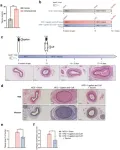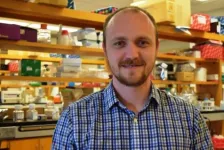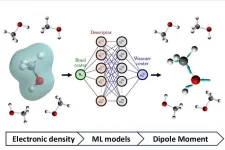(Press-News.org) The team developed a high-throughput imaging platform to assess the influence of nearly 3,500 mutations on protein location. They found that roughly one in six disease-causing mutations led to proteins ending up in the wrong location in the cell.
“Technological advances in genetic sequencing have allowed researchers to identify thousands of protein mutations that cause disease,” said Jessica Lacoste, co-lead author on the study and postdoctoral fellow at U of T’s Donnelly Centre for Cellular and Biomolecular Research. “We are now able to identify these mutations in patients at the clinic, but we have no idea what their consequences are for cellular processes. This study was meant to help bridge that gap in knowledge.”
The study was published recently in the journal Cell.
There are several ways genetic mutations can affect proteins produced in the cell. For example, they can reduce their overall stability by impairing their ability to fold, alter their interactions with other proteins or disrupt their movement to various regions of the cell. While the first two effects have been fairly well-studied, much less is known about the third. Improving our understanding of the impact of mutations on protein localization is essential to elucidating the critical role of this malfunction in a wide range of human diseases.
The research team used a powerful microscope — as well as computational analysis to fill in gaps in their visual analysis — to compare the cellular journeys made by mutated proteins to those made by regular proteins. Through these methods, they learned that mislocalization occurs much more frequently than previously thought.
The researchers expected that proteins were in the wrong locations because of disruptions to their interactions with other proteins or to the trafficking signals that would normally guide them to the correct location. They were surprised to learn that the major drivers of misplaced proteins were, in fact, a breakdown in protein stability and the loss of their ability to integrate into membranes.
“We’ve created the first large-scale map to visualize the impact of mutations on protein localization within the cell,” said Mikko Taipale, co-principal investigator on the study and professor of molecular genetics at the Donnelly Centre and U of T’s Temerty Faculty of Medicine. “No one else has studied the impact of pathogenic missense mutations on a scale like this, where we’ve tracked the movement of proteins to different organelles. The patterns of mislocalization we’ve observed help explain disease severity caused by certain mutations and improve our understanding of mutations that were less studied.”
While protein mislocalization is not understood to the same degree as the general loss of protein stability or altered interactions with other proteins, it occurs nearly as often. The mutation most commonly linked to cystic fibrosis causes the affected protein to end up in the endoplasmic reticulum of the cell, where it remains instead of moving to its correct location on the cell surface. Drug therapies promoting the proper trafficking of the mutant protein are currently being used in the clinic to address this issue and improve the symptoms of patients.
“We’ve made our protein mislocalization database available as a comprehensive resource that can be used by other researchers to expand our collective knowledge on the effects of genetic variation on human disease,” said Anne Carpenter, co-principal investigator on the study and senior director of the Imaging Platform at the Broad Institute. “One particularly useful application of this data would be to identify compounds that could help mutant proteins localize correctly to treat rare diseases.”
This research was supported by the Canadian Institutes of Health Research, the Cancer Prevention and Research Institute of Texas, the National Institutes of Health, the Ontario Ministry of Research and Innovation, the Susan G. Komen Foundation and the University of Toronto Connaught Fund.
END
Researchers discover that errors in protein location are a common cause of disease
2024-10-25
ELSE PRESS RELEASES FROM THIS DATE:
Aston University researcher develops new optical technique that could revolutionise medical diagnostics
2024-10-25
New light technique could revolutionise non-invasive medical diagnostics
Orbital Angular Momentum could be harnessed to improve imaging and data transmission through biological tissues
Could eventually have potential to make procedures such as surgery or biopsies unnecessary.
An Aston University researcher has developed a new technique using light which could revolutionise non-invasive medical diagnostics and optical communication.
The research showcases how a type of light called the Orbital Angular Momentum (OAM) can be harnessed to improve imaging and data transmission through skin and other biological tissues.
A ...
Taurine reduces atherosclerotic plaque area and stability in mice
2024-10-25
Background and objectives
Previous studies suggest that taurine supplementation may attenuate atherosclerosis by reducing lipid levels. However, energy drinks containing taurine have been shown to increase blood pressure, a key risk factor for atherosclerosis. Thus, the role of taurine in atherosclerosis remains controversial. This study aimed to investigate the effect of taurine on the development of atherosclerotic plaques.
Methods
Plasma taurine levels were measured in 105 patients with varying degrees of coronary heart disease and in 40 healthy individuals using 1,2-13C2-taurine-based ultra-performance ...
Immune cell discovery offers new potential for cancer immunotherapy
2024-10-25
Atlanta, GA — Oct. 23, 2024 — Researchers at Winship Cancer Institute of Emory University have identified a novel type of immune cell, called the stem-like CD4 T cell, that plays a pivotal role in anti-tumor immunity. The pre-clinical findings, published in Nature, highlight the potential to activate these cells to fight tumors more effectively, offering new hope for broader treatment success, particularly in patients with cancer that is unresponsive to current immunotherapies.
Led by Haydn ...
“Well-man” thrown from castle identified from 800-year-old Norse saga
2024-10-25
A passage in the Norse Sverris Saga, the 800-year-old story of King Sverre Sigurdsson, describes a military raid that occurred in AD 1197, during which a body was thrown into a well at Sverresborg Castle, outside Trondheim in central Norway, likely as an attempt to poison the main water source for the local inhabitants. A new study published in the Cell Press journal iScience on October 25 describes how researchers used ancient DNA to corroborate the events of the saga and discover details about the “Well-man,” blending history and archaeology ...
Social media and suicide risk in youth
2024-10-25
About The Study: This overview identifies research gaps and methodological challenges that need to be addressed to guide intervention strategies and future policy relevant to youth and suicide risk.
Corresponding Author: To contact the corresponding author, Lisa H. Jaycox, PhD, email lisa.jaycox@nimh.gov.
To access the embargoed study: Visit our For The Media website at this link https://media.jamanetwork.com/
(doi:10.1001/jamanetworkopen.2024.41499)
Editor’s Note: Please see ...
Hospitalization for COVID-19, other respiratory infections, and postacute patient-reported symptoms
2024-10-25
About The Study: This cohort study found that postacute infection syndrome is not unique to COVID-19; it can also occur in people with other severe lower respiratory tract infections (LRTIs). However, compared with other LRTIs, COVID-19 appeared to impose an extra burden of neurological, cognitive, and fatigue symptoms. These findings highlight the similarities and differences between post–COVID-19 condition and postacute infection syndrome triggered by other pathogens, which will inform tailored clinical management and offer mechanistic insights into these previously overlooked syndromes.
Corresponding Author: To contact the corresponding author, Junqing Xie, ...
Metabolic bariatric surgery in the era of GLP-1 receptor agonists for obesity management
2024-10-25
About The Study: This cross-sectional study of privately insured patients found a more than 2-fold increase in use of glucagon-like peptide-1 receptor agonists (GLP-1 RAs) as anti-obesity medications from 2022 to 2023, with a 25.6% decrease in the rate of metabolic bariatric surgery during the same period. Our results provide a national contemporaneous estimate of the decline in metabolic bariatric surgery associated with the era of GLP-1 RAs.
Corresponding Author: To contact the corresponding author, Thomas C. Tsai, ...
‘The way to a man’s heart disease’: Can social expectations of masculinity be bad for cardiovascular health?
2024-10-25
Cardiovascular disease remains a top cause of sickness and death in the U.S. and worldwide. Doctors and researchers have it especially high on their radar because it’s more modifiable and preventable than many other diseases and causes of death.
Importantly, though, modification and prevention rely on early detection and mitigation of risk factors like hypertension and high cholesterol. Unfortunately, detection and mitigation are suboptimal throughout the U.S. population: Experts estimate that up to 75% of young adults who have risk factors such as hypertension and high cholesterol are unaware ...
New machine learning model quickly and accurately predicts dielectric function
2024-10-25
Researchers Tomohito Amano and Shinji Tsuneyuki of the University of Tokyo with Tamio Yamazaki of CURIE (JSR-UTokyo Collaboration Hub) have developed a new machine learning model to predict the dielectric function of materials, rather than calculating from first-principles. The dielectric function measures the polarization of negative and positive charges within materials, the phenomenon underlying dielectric materials. Thus, the fast and accurate prediction of dielectric function facilitates the development of novel dielectric materials, an ingredient of many cutting-edge technologies such as 6G ...
Malicious social media bots increased significantly during the COVID-19 pandemic and continue to influence public health communication
2024-10-25
The information environment in Finland during the coronavirus pandemic was exceptional and intense in many ways. The spread of disinformation and the number of actors involved reached unprecedented levels. The demand for accurate information was enormous, and the situation was constantly evolving. Information was disseminated through various channels. Official information played a crucial role, but at the same time, social media posed challenges in the fight against false and misleading information.
Malicious bots increased significantly during the pandemic. The operation of bots – i.e. ...





